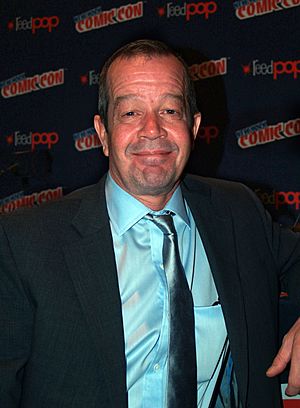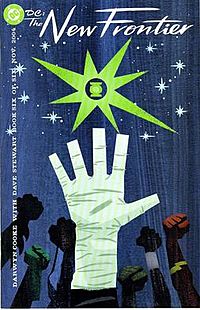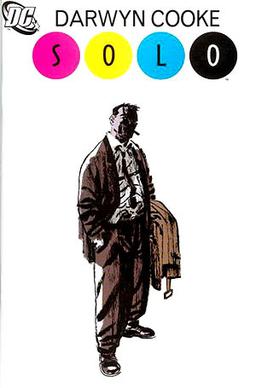Darwyn Cooke facts for kids
Quick facts for kids Darwyn Cooke |
|
|---|---|

Cooke at the 2013 New York Comic Con
|
|
| Born | November 16, 1962 Toronto, Ontario, Canada |
| Died | May 14, 2016 (aged 53) Safety Harbor, Florida, U.S. |
| Area(s) | Cartoonist, Writer, Penciller, Inker, Letterer |
|
Notable works
|
|
| Awards |
|
| Spouse(s) | Marsha Stagg (m. 2012–2016; his death) |
Darwyn Cooke (born November 16, 1962 – died May 14, 2016) was a talented Canadian comics artist, writer, and cartoonist. He also worked as an animator. He was famous for his work on popular comic books like Catwoman, DC: The New Frontier, and The Spirit.
Cooke's amazing work earned him many top awards. These included the Eisner, Harvey, and Joe Shuster Awards.
Contents
Early Life and Discovering Comics
Darwyn Cooke was born in Toronto, Canada, on November 16, 1962. His father worked in construction.
Cooke's love for comics started when he was very young. He watched the Batman TV show starring Adam West. His grandmother even saved some of his first drawings of Batman and Robin. He drew them with crayons when he was just five years old!
He really got into comics as a teenager. At 13, after reading a Spectacular Spider-Man comic, he decided he wanted to be an artist. He bought art supplies right away and tried to copy the drawings. Soon after, he read Detective Comics #439 and knew that creating comics was his true calling. He also practiced by tracing panels from Will Eisner's The Spirit.
Cooke believed his unique art style came from focusing on the comics that inspired him. Even though his father didn't think comics were a good career, Cooke followed his passion. He attended George Brown College for a year.
A Career in Comics and Animation
In 1985, Cooke tried to get his first professional comic book job. He traveled to DC Comics' offices in New York City. This trip led to his first published work in New Talent Showcase #19.
However, it was hard to make enough money from comics back then. So, Cooke left the industry for about 15 years. During that time, he worked in Canada as an art director and graphic designer. He even started his own design studio.
Animation Work
In the early 1990s, Cooke wanted to return to comics. But he found it hard to get work. Then, he saw an ad from Warner Bros. Animation looking for storyboard artists. He applied and was hired! He was surprised to find jobs like that available.
His successful application included 14 pages of art. These pages were later published as the graphic novel Batman: Ego. Cooke worked as a storyboard artist for shows like The New Batman Adventures and Superman: The Animated Series.
In 1999, he designed and animated the cool opening sequence for Batman Beyond. He also worked as a director for Men in Black: The Series for a year. In 2014, he created a special Batman Beyond animated short. It celebrated Batman's 75th anniversary.
Justice League: The New Frontier Film
In 2006, Warner Bros. Animation decided to make animated movies based on popular DC comic books. Cooke's comic, DC: The New Frontier, was chosen as the second film.
Cooke helped a lot with the movie. He storyboarded parts of it, improved the dialogue, and designed most of the characters. He worked hard to make sure important characters like Wonder Woman and Lois Lane stayed in the film. He felt they were "the heart of the story."
Cooke was happy when he learned his former colleague, David Bullock, would direct the film. He trusted Bullock to do a great job.
Working with DC Comics
In the late 1990s, a DC Comics art director found Cooke's old Batman story idea. This led to the 2000 graphic novel Batman: Ego. This book marked Cooke's full return to comics at age 37. Cooke described Batman: Ego as a story about Batman and Bruce Wayne talking about their lives.
Revamping Catwoman
In 2001, Cooke teamed up with writer Ed Brubaker to give the Catwoman character a fresh new look. They started with a story in Detective Comics that led to a new Catwoman series. Cooke helped redesign her costume and her whole world. He worked on the series for a few issues.
In 2002, Cooke wrote and drew Selina's Big Score. This story showed what happened to Catwoman right before her new series. Cooke said this was his favorite work he ever did.
DC: The New Frontier Comic Series
Cooke's next big project was DC: The New Frontier in 2004. This was a six-issue miniseries that connected the end of the Golden Age with the start of the silver age of comic books in the DC Universe. Cooke wanted to show who the Justice League heroes were before they became a team.
The story is set in the 1950s and features many super-heroes. Cooke was inspired by 1950s comics, movies, and books like The Right Stuff. He introduced DC characters in the same order they were first published. For the art, he looked at 1950s advertising and the work of artists like Jack Kirby and Alex Toth.
Cooke used a storytelling style where different parts of the story slowly came together. He focused a lot on Green Lantern Hal Jordan. He wanted to show why the character was cool. Cooke even spoke with real fighter pilots to make Jordan's story accurate.
The title of the comic, The New Frontier, was inspired by John F. Kennedy's famous 1960 speech. Cooke felt this speech captured the promise of modern America. A special collected edition of the series was released in 2006 with extra pages.
Other Exciting Projects
In 2004, Cooke also worked on DC's Solo anthology. His issue (#5, Aug. 2005) had several different stories. It even won an Eisner Award for "Best Single Issue" in 2006.
In 2006, Cooke worked with writer Jeph Loeb on Batman/The Spirit. This was a crossover comic where Batman met The Spirit. After that, Cooke wrote and drew an ongoing Spirit series. He felt it was a huge honor and a bit scary to work on a character created by the legendary Will Eisner. Cooke made some changes to characters like Ebony White to update them. He won several Joe Shuster Awards for his work on Batman/The Spirit and The Spirit.
Darwyn Cooke also wrote the first six issues of Superman Confidential in 2006. This series told stories from Superman's early career. Cooke explored Superman's early fears about his powers. He won a Joe Shuster Award for "Outstanding Canadian Comic Book Writer" for this series.
In 2008, Cooke worked on an issue of Jonah Hex, a Western comic. He enjoyed writing a Western story set in Canada.
Cooke also worked on Before Watchmen: Minutemen and wrote Before Watchmen: Silk Spectre in 2012–2013. He was initially hesitant to work on these comics because the original Watchmen is so famous. But he eventually took on the project.
Vertigo Comics Work
Cooke also created a comic called The Twilight Children with writer Gilbert Hernandez. This story is set in a Latin American fishing village. It mixes science fiction with magic realism. The villagers' lives change when strange things start happening.
Marvel Comics and IDW Publishing
Before DC: The New Frontier, Cooke did some freelance work for Marvel Comics. He worked on titles like X-Force and Spider-Man's Tangled Web.
Later, Cooke had a disagreement with Marvel. He had proposed a plan for their children's comic line, but Marvel gave his ideas to other creators without telling him.
In 2009, IDW Publishing released Cooke's Richard Stark's Parker: The Hunter. This was a comic book adaptation of a novel by Donald Westlake. Cooke adapted three more "Parker" novels for IDW: The Outfit, The Score, and Slayground. He handled all the art and design for these books.
Image Comics
In 2015, Image Comics announced a new project by Cooke called Revengeance. This was going to be a three-part psychological thriller and dark comedy set in Toronto. Cooke planned to draw it himself. Sadly, Revengeance was not released before his death in 2016.
Personal Life
Darwyn Cooke married Marsha Stagg in 2012. They lived in western Florida.
His favorite movie was The Wizard of Oz. He said it was the first movie that scared him and sparked his imagination.
His Passing
On May 13, 2016, Cooke's wife shared sad news on his blog. She announced that he was battling a serious illness. Darwyn Cooke passed away the next morning, on May 14, 2016.
Many comic creators shared their sadness and memories of working with him. They also encouraged fans to read his amazing works.
His Legacy
After Cooke's passing, DC Comics released a statement. They called him "one of our medium's true innovators." They compared his bold and direct art style to other legendary artists like Joe Kubert and Jack Kirby.
Cooke was known for being very determined in his work. Other artists in the comic book industry said that his strong will "opened doors for lots of us." This means his dedication helped make things better for many creators.
Awards and Honors
Darwyn Cooke won many awards for his work. He received thirteen Eisner Awards, eight Harvey Awards, and five Joe Shuster Awards. Most of these were for his work on DC: The New Frontier and the Richard Stark's Parker series.
Cooke once said that while he appreciated awards, he didn't pay too much attention to them. However, winning his first Eisner Award in 2005 for DC: The New Frontier made him feel truly happy. It showed him that he was on the right path with his comic career.
Eisner Awards
- Best Finite Series/Limited Series – 2005 DC: The New Frontier
- Best Single Issue/Single Story – 2006 Solo #5
- Best Single Issue/Single Story – 2007 Batman/The Spirit #1
- Best Graphic Album: Reprint – 2007 Absolute DC: The New Frontier
- Best Publication Design – 2007 Absolute DC: The New Frontier
- Best Adaptation from Another Work – 2010 Richard Stark's Parker: The Hunter
- Best Writer/Artist – 2011 Darwyn Cooke, Richard Stark's Parker: The Outfit
- Best Graphic Album: Reprint – 2012 Richard Stark's Parker: The Martini Edition
- Best Short Story – 2012 "The Seventh" in Richard Stark's Parker: The Martini Edition
- Best Adaptation from Another Medium – 2013 Richard Stark's Parker: The Score
- Best Adaptation from Another Medium – 2014 Richard Stark's Parker: Slayground
- Best Letterer/Lettering – 2014 Darwyn Cooke, Richard Stark's Parker: Slayground
- Best Cover Artist – 2015 Darwyn Cooke, DC Comics Darwyn Cooke Month Variant Covers
Harvey Awards
- Best Artist or Penciller – 2005 Darwyn Cooke, for DC: The New Frontier
- Best Continuing or Limited Series – 2005 DC: The New Frontier
- Best Graphic Album of Previously Published Work – 2007 Absolute New Frontier
- Best Cartoonist (Writer/Artist) – 2008 Darwyn Cooke, for The Spirit
- Best Cartoonist (Writer/Artist) – 2010 Darwyn Cooke, for Richard Stark's Parker: The Hunter
- Best Artist or Penciller – 2011 Darwyn Cooke, for Richard Stark's Parker: The Outfit
- Best Cartoonist (Writer/Artist) – 2011 Darwyn Cooke, for Richard Stark's Parker: The Outfit
- Best Graphic Album of Original Work – 2013 Richard Stark's Parker: The Score
- Harvey Awards Hall of Fame – 2017 (added after his passing)
Joe Shuster Awards
- Outstanding Cartoonist (writer and artist) – 2005 Darwyn Cooke for DC: The New Frontier
- Outstanding Artist – 2007 Darwyn Cooke and J. Bone for Batman/The Spirit #1
- Outstanding Cartoonist (writer and artist) – 2007 Darwyn Cooke for The Spirit #1
- Outstanding Writer – 2007 Darwyn Cooke for Superman Confidential #1–2
- Outstanding Cover – 2010 Darwyn Cooke for Richard Stark's Parker: The Hunter
Screenwriting
Television
- Justice League Unlimited (2005)
- DC Nation Shorts: Batman Beyond (2014)
Film
- Justice League: The New Frontier (2008): additional material
Images for kids
See also
 In Spanish: Darwyn Cooke para niños
In Spanish: Darwyn Cooke para niños




